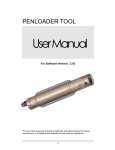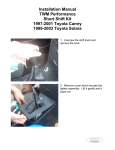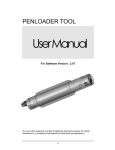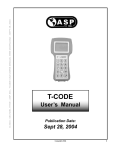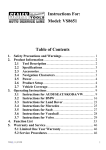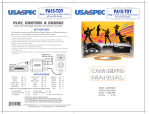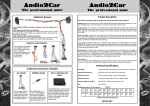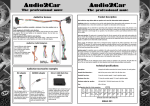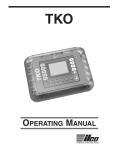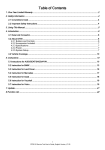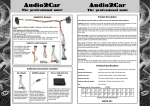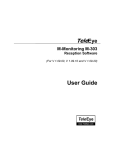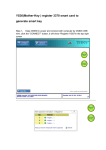Download User Manual - Logikey.us
Transcript
PENLOADER TOOL UserManual For Software Version: 2.01 The use of this apparatus is limited to legitimate and legal purposes for vehicle maintenance, in compliance with federal and state laws and regulations. i Thumbwheel Setting Operation 00 Write from memory block 0 01 Write from memory block 1 02 Write from memory block 2 03 Write from memory block 3 04 Display keys for 3key 16 bit 05 Prog file: 3key16bit 06 Prog file: 16bit 07 Prog file: 32bit 08 Prog file: 47010 09 Prog file: 34010 10 Prog file: 50020 11 Prog file: 60330 12 Prog file: 60230 13 Prog file: 33110 14 Prog file: Aa010 15 Prog file: 35090 16 Prog file: 60220 17 Prog file: 08010 18 Prog file: 50050 19 Prog file: 48020 20 Prog file: 0e010 21 Prog file: 47020 22 Prog file: 50030 23 Prog file: 50031 24 Prog file: 24020 25 Prog file: nontrans 26 Prog file: Red_Black 27 Display Red and Black keys 28 to 88 Not in use 89 Jeep Liberty 95080 PIN read 90 Nissan 05 PIN read 91 Nissan 09 PIN read 92 VW Beetle PIN read 93 Isuzu PIN read 94 Chrysler PIN read ii 95 Restore original contents 98 Switch to THUMB 1 settings 99 Display serial number and power supply voltage THUMB 1 settings: Thumbwheel Setting Operation 00 Send memory block 0 to computer 01 Send memory block 1 to computer 02 Send memory block 2 to computer 03 Send memory block 3 to computer 04 Receive data from computer and save in memory block 0 05 Receive data from computer and save in memory block 1 06 Receive data from computer and save in memory block 2 07 Receive data from computer and save in memory block 3 08 Read and save to memory block 0 09 Read and save to memory block 1 10 Read and save to memory block 2 11 Read and save to memory block 3 12 Save last to memory block 0 13 Save last to memory block 1 14 Save last to memory block 2 15 Save last to memory block 3 99 Display serial number and power supply voltage iii 1 INTRODUCTION 1 2 PRODUCT FEATURES 2 3 4D QUICK RESET ORANGE DONGLE 4 4 PENLOADER OPERATION 5 4.1 General Operation 5 4.2 Visual and Audible Cues 9 4.3 Memory Blocks 11 4.4 Restore Original Contents 11 4.5 THUMB 1 Settings 12 5 THUMBWHEEL SELECTIONS IN DETAIL 14 5.1 General Operation 14 5.2 THUMB 1 Settings 36 iv 1 Introduction The Penloader was designed to provide a tool that can be used to program memory devices installed on circuit boards, as well as read existing PINs. The tool is simple to use and requires no external computers, keypad entry devices, adaptor boards or cables. Features of the tool are: Small sized unit for hand held use 4 digit alpha-numeric display Simple to use Programming options selected through a 2 digit thumbwheel switch Onboard probes with spring loaded protective cover, for programming 8 pin SOIC packages Supports Microwire, I2C and SPI devices Powered by rechargeable batteries or external 12V dc supply Provides measurement of power supply voltage (battery and external supply) Includes dual LED lamps to illuminate area around device to be programmed Audio feedback to user Capability to read and display PIN numbers 60 second auto power off when not in use Software is field updateable using a Windows PC and a serial cable 4 on board memory blocks that can be used to save 4 unique user files. Restore operation that can be used to restore contents of last device programmed. 1 2 Product Features Figure 1 – Penloader Unit 2 Item Description 1 Thumbwheel selector 2 On/Off button 3 START buttons 4 4 character display 5 Neoprene grip 6 Spring probes 7 12V dc input connector 3 3 4D Quick Reset Orange Dongle A “4D Quick Reset Orange Dongle” is included in the Penloader package, to provide an easy method of adding a key for the Toyota and Lexus models specified below. The User Manual for this product is provided in Appendix A. It is suggested that the “4D Quick Reset Orange Dongle” be used first with the vehicles identified in the table below, and the Penloader used if there is a problem adding a key using the “4D Quick Reset Orange Dongle”. Type of operation: Add key Manufacturer(s): Toyota, Lexus (models specified in the following table). Make Model Year Toyota 4Runner 2003 -2009 Toyota Camry 2003-2009 Toyota Solara 2004-2009 Toyota Landcruiser 2003-2009 Toyota Yaris 2005-2009 Lexus ES 330 2004-2006 Lexus GX 470 2003-2007 Lexus RX 300 2004-2006 Lexus RX 350 2007-2008 Lexus LS 430 2004-2006 Lexus SC 300 2002-2006 Lexus SC 400 2002-2006 Lexus SC 430 2002-2007 Lexus LX 470 2003-2007 4 4 Penloader Operation This tool provides a set of programming and PIN read functions to help the locksmith when programming new transponder keys and proxy. General Operation 4.1 The basic operating procedure for using the Penloader is as follows: (i) (ii) (iii) (iv) (v) (vi) (vii) Remove module containing memory device to be programmed, from the vehicle, and disassemble to provide access to the memory device to be programmed or read. Set thumbwheel to the required number (refer to Table 3.1 below). Power up the Penloader (thumbwheel must not be set to 98 before power up). Position the Penloader over the 8 pin memory device ensuring that the spring probes are making good contact with the legs on the memory device. Where possible, a “Flash device identifier” is specified to help locate the correct 8 pin device on the circuit board. Figure 2 below shows how to locate pin 1 on the 8 pin memory device. It is important that the spring probe identified as “1”, is in contact with Pin 1 on the 8 pin memory device. Push the START button. The 4 character display will show status as the programming/read operation proceeds. The Penloader unit will also provide audio cues during the operation (ref section 4.2 below). On completion the display will identify whether the programming operation was successful or not. In the case of PIN reads, the display will show the 4 digit PIN (and hold it for 5 seconds) if the operation was successful. 5 Figure 2 – Locator for Pin 1 The following table shows the options that are selectable using the thumbwheel. 6 Thumbwheel Setting Penloader Function 00 Write using data from memory block 0 01 Write using data from memory block 1 02 Write using data from memory block 2 03 Write using data from memory block 3 04 Displays 2 keys for use with thumbwheel setting 05 05 Lexus or Toyota 3 key file program 06 Lexus or Toyota - 16bit file program 07 Lexus or Toyota - 32bit file program 08 Toyota Prius - 47010 file program 09 Toyota Sequoia - 34010 file program 10 Lexus LS400 - 50020 file program 11 Lexus GX470 - 60330 file program 12 Lexus LX470 - 60230 file program 13 Lexus ES330 - 33110 file program 14 Toyota Camry – aa010 file program 15 Toyota 4runner - 35090 file program 16 Toyota Landcruiser - 60220 file program 17 Toyota Sienna - 08010 file program 18 Lexus LS430 - 50050 file program 7 19 Lexus RX330 - 48020 file program 20 Lexus RX330 - 0e010 file program 21 Toyota Prius - 47020 file program 22 Lexus LS430 - 50030 file program 23 Lexus LS430 - 50031 file program 24 Lexus SC430 - 24020 file program 25 Lexus or Toyota - nontrans file program 26 Honda Red/Black keys program 27 Displays 2 keys for use with thumbwheel setting 26 28 - 88 Not used 89 Jeep Liberty 95080 PIN read 90 Nissan 2005 PIN read 91 Nissan 2009 and up PIN read 92 VW Beetle 2000 PIN read 93 Isuzu 2003-2005 PIN read 94 Chrysler PIN read 95 Restore original contents 98 Switch to THUMB 1 settings 99 Displays unit serial number and power supply voltage Table 4.1 – Thumbwheel selection options 8 4.2 Visual and Audible Cues When the Penloader is used to program an update into a memory device it will provide both visual and audio cues to the user. The following table defines these cues and their definition. Note that all visual cues are displayed on the 4 character display. 9 Visual Cue Audio Cue IDNT Faint ticking sound, with ticks approximately 1 second apart PROG Machine gun type sound VRFY Same sound as used for PROG. OK Pseudo “charge” tune. FAIL Low tone held for 2 seconds. READ None SAVE None Definition The Penloader is determining what type and size device it is currently positioned over. The Penloader is programming the external memory device. The Penloader is comparing the data in the programmed part, with the data used to perform the program function. The VRFY operation was successful, and the data in the programmed part matches the data used in the program operation. An error occurred, or the Penloader could not determine the type of device. The Penloader unit is reading data from an external memory device. The Penloader unit is saving data a memory block. Table 4.2 – Visual and audible cues 10 4.3 Memory Blocks The Penloader contains four onboard memory blocks, which can be used for the purpose of saving and retrieving custom data files. Each memory block can hold up to 2K Bytes (2048 Bytes) of data. To identify the memory blocks, they are numbered as 0, 1, 2 and 3. Data can be read from an external memory device and saved to any of the four memory blocks (THUMB 1 thumbwheel options 08 to 11 – refer to section 4.5). External memory devices can also be programmed using data sourced from any of the four memory blocks (thumbwheel options 00 through 03). In addition, the Penloader contains the capability to send the contents of any of the memory blocks to an external computer (via RS-232) for viewing and editing purposes (THUMB 1 thumbwheel options 00 to 03); and also to receive, and save to a memory block, data files from an external computer (THUMB 1 thumbwheel options 04 to 07). Each memory block has an associated comment field, which can be used to name or add a note for a particular memory block. The comment field may not exceed 58 characters in length (including spaces). To add a comment field, an external computer must be used. This procedure is described in a separate document called “Penloader Tool – Data Send and Receive Manual”. 4.4 Restore Original Contents The Penloader also contains a reserved “Restore” memory block which is used by the Penloader to save the contents of an external memory device before it overwrites it with new data. When programming an external memory device, and after the START button is pressed, and the Penloader has 11 identified the external device to be programmed, the Penloader reads the contents of the external memory device, and saves it to the “Restore” memory block. Should the user desire to restore the original contents of the external memory device after programming, this is made possible through the use of the thumbwheel 95 setting. It is important to note that the “Restore” memory block is overwritten by each subsequent programming of an external device. As a consequence, it is only possible to restore the last contents of the last external memory device programmed. It is possible to permanently save the contents of the “Restore” memory block, as described in section 5.2.4. 4.5 THUMB 1 Settings The Penloader contains a second bank of thumbwheel settings, referred to as the THUMB 1 settings. These settings are invoked by setting the thumbwheel to 98 prior to powering on the Penloader. When this is done, the display will indicate “THUMB 1 active”, and the thumbwheel selections will switch over to the THUMB 1 settings table, as follows: Thumbwheel Setting Operation 00 Send memory block 0 to an external computer 01 Send memory block 1 to an external computer 02 Send memory block 2 to an external computer 03 Send memory block 3 to an external computer 12 04 Receive data from computer and save in memory block 0 05 Receive data from computer and save in memory block 1 06 Receive data from computer and save in memory block 2 07 Receive data from computer and save in memory block 3 08 Read and save to memory block 0 09 Read and save to memory block 1 10 Read and save to memory block 2 11 Read and save to memory block 3 12 Save last to memory block 0 13 Save last to memory block 1 14 Save last to memory block 2 15 Save last to memory block 3 99 Display serial number and power supply voltage These thumbwheel settings will remain in place until the power is cycled, with the thumbwheel set to some setting other than 98. 13 5 Thumbwheel Selections In Detail 5.1 General Operation The following sections describe the operation of the Penloader under the general thumbwheel settings. 5.1.1 Thumbwheel Settings 00 through 03 File: Sourced from Memory Block (0,1,2 or 3) Flash device identifier: Depends on manufacturer Type of operation: Programming Manufacturer(s): Any These thumbwheel setting are used to program a memory device using the contents of one of the four memory blocks provided. Set thumbwheel to 00, 01, 02, or 03 depending on which memory block (1, 2, 3, or 4) should source the data to be programmed into to the external device. Note that the contents of the comment field will scroll on the display when the thumbwheel is set to one of these selections. To perform the programming function use the procedure described in section 4.1. Display must display “OK” at the end of the procedure, else the programming operation failed. 14 5.1.2 Thumbwheel Setting 04 This thumbwheel setting is used to display the 2 keys programmed into a memory device using Thumbwheel setting 05. The keys are displayed in 4 character increments, as follows: (i) (ii) (iii) (iv) (v) Before starting, perform the programming procedure as described in section 5.1.3 below. Set thumbwheel to 28. Press the START button. The display will scroll until “KEY1” is displayed, then the scroll operation will pause. KEY1 is the first Key, and KEY2 is the second Key. Press the START button again to continue the display scroll to the next 4 digits of the key value. Continue step (iv) until all 28 digits of both keys have been displayed. Pressing START again will scroll the data from the beginning again. 5.1.3 Thumbwheel Setting 05 File: 3 key16bit Flash device identifier: IC900 Type of operation: Programming Manufacturer(s): Toyota, Lexus – Type 1 ECU (models specified in the following table). Model Year ECU Location 4Runner 1998-2001 Avalon 1998-2003 Behind glove box Behind glove box Camry 1998-2000 Behind glove box Solara 1998-2000 Behind glove box Highlander 2001-2003 Behind glove box Landcruiser 1998-2000 Behind glove box MR2 2001-2003 Behind driver seat 15 Rav 4 2002-2003 Behind glove box Sienna 1998-2003 Behind glove box ES 300 1998-2001 Behind glove box GS 300 1998-2000 Under hood, driver’s side GS 400 1998-2000 Under hood, driver’s side LS 400 1998-2000 LX 470 1998-2000 Behind glove box Under hood RX 300 1999-2003 Under hood SC 300 1998-2000 Below glove box, under carpet SC 400 1998-2000 Below glove box, under carpet Note: Use this option if the immobilizer will not enter “Learn” mode after re-programming using Thumbwheel selection 30. To perform the programming function use the procedure described in section 4.1. Display must display “OK” at the end of the procedure, else the programming operation failed. After the programming procedure successfully completes, set Thumbwheel to 28 to display the two Key values programmed. 16 5.1.4 Thumbwheel Setting 06 File: 16bit Flash device identifier: IC900 Type of operation: Programming Manufacturer(s): Toyota, Lexus – Type 1 ECU (models specified in the following table). Model Year ECU Location 4Runner 1998-2001 Avalon 1998-2003 Behind glove box Behind glove box Camry 1998-2000 Behind glove box Solara 1998-2000 Behind glove box Highlander 2001-2003 Behind glove box Landcruiser 1998-2000 Behind glove box MR2 2001-2003 RAV 4 2002-2003 Behind driver seat Behind glove box Sienna 1998-2003 Behind glove box ES 300 1998-2001 Behind glove box GS 300 1998-2000 Under hood, driver’s side GS 400 1998-2000 Under hood, driver’s side LS 400 1998-2000 LX 470 1998-2000 Behind glove box Under hood RX 300 1999-2003 Under hood SC 300 1998-2000 Below glove box, under carpet SC 400 1998-2000 Below glove box, under carpet To perform the programming function use the procedure described in section 4.1. Display must display “OK” at the end of the procedure, else the programming operation failed. 17 After programming is successfully completed, follow the procedure described in Appendix C, section C.1.1 to register keys into the ECU. If the immobilizer will not enter “Learn” mode after reprogramming, reprogram using Thumbwheel setting 29. Note: If vehicle will only register 1 key after programming this is an indication that it probably uses a Type 2 ECU, and was programmed with the wrong file. Reflash with the correct file. 5.1.5 Thumbwheel Setting 07 File: 32bit Flash device identifier: IC900 Type of operation: Programming Manufacturer(s): Toyota, Lexus – Type 2 ECU (models specified in the following table). Model Year ECU Location 4Runner 2002 Behind glove box Camry 2001-2009 Behind glove box Solara 2001-2004 Behind glove box LandCruiser 2001-2002 Behind glove box Sequoia 2001-2002 Behind glove box ES 300 2002-2003 Behind glove box GS 300 2001-2003 Under hood, driver’s side GS 430 2001-2003 Under hood, driver’s side IS 300 2001-2003 Under hood, driver’s side LX 470 2001-2002 Behind glove box To perform the programming function use the procedure described in section 4.1. Display must display “OK” at the 18 end of the procedure, else the programming operation failed. After programming is successfully completed, follow the procedure described in Appendix C, section C.1.1 to register keys into the ECU. Note: If vehicle will only register 1 key after programming this is an indication that it probably uses a Type 1 ECU, and was programmed with the wrong file. Reprogram with the correct file. 5.1.6 Thumbwheel Setting 08 File: 47010 Flash device identifier: IC Type of operation: Programming Manufacturer(s): Toyota (models specified in the following table). Model Prius Year Immo Location 2001-2003 Under dash board, above steering column. Must drop the column – 10mm bolt to release the bracket located in left corner behind roll bar. To perform the programming function use the procedure described in section 4.1. Display must display “OK” at the end of the procedure, else the programming operation failed. After programming is successfully completed, follow the procedure described in Appendix C, section C.4.1 to register keys into the Immobilizer. After programming all modules must be resynchronized by performing the following procedure: 19 5.1.7 Thumbwheel Setting 09 File: 34010 Flash device identifier: IC2 Type of operation: Programming Manufacturer(s): Toyota (models specified in the following table). Model Year Immo Location Sequoia 2003 and newer Behind cluster. Must be a 4D-67 transponder. To perform the programming function use the procedure described in section 4.1. Display must display “OK” at the end of the procedure, else the programming operation failed. Important: One of the pins of the blue colored component in the corner of the board next to IC1, must be connected to GND before trying to program IC2 (refer to photo in Appendix B). After programming is successfully completed, follow the procedure described in Appendix C, section C.6.1 to register keys into the Immobilizer. 5.1.8 Thumbwheel Setting 10 File: 50020 Flash device identifier: IC2 Type of operation: Programming Manufacturer(s): Lexus (models specified in the following table). Model Year ECU Location LS 400 1997 Behind glove box To perform the programming function use the procedure described in section 4.1. Display must display “OK” at the 20 end of the procedure, else the programming operation failed. After programming is successfully completed, follow the procedure described in Appendix C, section C.3.1 to register keys into the ECU. 5.1.9 Thumbwheel Setting 11 File: 60330 Flash device identifier: Type of operation: Programming Manufacturer(s): Lexus (models specified in the following table). Model Year Immo Location GX 470 2003-2004 Behind instrument cluster To perform the programming function use the procedure described in section 4.1. Display must display “OK” at the end of the procedure, else the programming operation failed. After programming is successfully completed, follow the procedure described in Appendix C, section C.5.1 to register keys into the Immobilizer. 5.1.10 Thumbwheel Setting 12 File: 60230 Flash device identifier: Type of operation: Programming Manufacturer(s): Lexus (models specified in the following table). Model Year Immo Location LX 470 2003-2004 Behind glove box 21 To perform the programming function use the procedure described in section 4.1. Display must display “OK” at the end of the procedure, else the programming operation failed. After programming is successfully completed, follow the procedure described in Appendix C, section C.5.1 to register keys into the Immobilizer. 5.1.11 Thumbwheel Setting 13 File: 33110 Flash device identifier: Type of operation: Programming Manufacturer(s): Lexus (models specified in the following table). Model Year Immo Location ES 330 2004 Behind glove box To perform the programming function use the procedure described in section 4.1. Display must display “OK” at the end of the procedure, else the programming operation failed. After programming is successfully completed, follow the procedure described in Appendix C, section C.6.1 to register keys into the Immobilizer. 5.1.12 Thumbwheel Setting 14 File: aa010 Flash device identifier: Type of operation: Programming Manufacturer(s): Toyota (models specified in the following table). 22 Model Year Immo Location Camry 2001-2004 Behind glove box Solara 2003-2004 Behind glove box To perform the programming function use the procedure described in section 4.1. Display must display “OK” at the end of the procedure, else the programming operation failed. After programming is successfully completed, follow the procedure described in Appendix C, section C.6.1 to register keys into the Immobilizer. 5.1.13 Thumbwheel Setting 15 File: 35090 Flash device identifier: Type of operation: Programming Manufacturer(s): Toyota (models specified in the following table). Model Year Immo Location 4Runner 2003-2004 Behind glove box To perform the programming function use the procedure described in section 4.1. Display must display “OK” at the end of the procedure, else the programming operation failed. After programming is successfully completed, follow the procedure described in Appendix C, section C.7.1 to register keys into the Immobilizer. 23 5.1.14 Thumbwheel Setting 16 File: 60220 Flash device identifier: IC900 Type of operation: Programming Manufacturer(s): Toyota (models specified in the following table). Model Year Immo Location LandCruiser 2003-2004 Behind glove box To perform the programming function use the procedure described in section 4.1. Display must display “OK” at the end of the procedure, else the programming operation failed. After programming is successfully completed, follow the procedure described in Appendix C, section C.7.1 to register keys into the Immobilizer. 5.1.15 Thumbwheel Setting 17 File: 08010 Flash device identifier: IC900 Type of operation: Programming Manufacturer(s): Toyota (models specified in the following table). Model Year Immo Location Sienna 2004 Above center dash To perform the programming function use the procedure described in section 4.1. Display must display “OK” at the end of the procedure, else the programming operation failed. After programming is successfully completed, follow the procedure described in Appendix C, section C.7.1 to register keys into the Immobilizer. 24 5.1.16 Thumbwheel Setting 18 File: 50050 Flash device identifier: Type of operation: Programming Manufacturer(s): Lexus (models specified in the following table). Model Year Immo Location LS 430 2004 Above navigation system To perform the programming function use the procedure described in section 4.1. Display must display “OK” at the end of the procedure, else the programming operation failed. After programming is successfully completed, follow the procedure described in Appendix C, section C.6.1 to register keys into the Immobilizer. 5.1.17 Thumbwheel Setting 19 File: 48020 Flash device identifier: Type of operation: Programming Manufacturer(s): Lexus (models specified in the following table). Model Year Immo Location RX 330 2004 (VIN starts with “J”) Above center dash To perform the programming function use the procedure described in section 4.1. Display must display “OK” at the end of the procedure, else the programming operation failed. After programming is successfully completed, follow the procedure described in Appendix C, section C.6.1 to register keys into the Immobilizer. 25 5.1.18 Thumbwheel Setting 20 File: 0e010 Flash device identifier: Type of operation: Programming Manufacturer(s): Lexus (models specified in the following table). Model Year Immo Location RX 330 2004 (VIN starts with “2”) Above center dash To perform the programming function use the procedure described in section 4.1. Display must display “OK” at the end of the procedure, else the programming operation failed. After programming is successfully completed, follow the procedure described in Appendix C, section C.6.1 to register keys into the Immobilizer. 5.1.19 Thumbwheel Setting 21 File: 47020 Flash device identifier: Type of operation: Programming Manufacturer(s): Toyota (models specified in the following table). Model Year Prius 2004 Immo Location Under dash board, above steering column. To perform the programming function use the procedure described in section 4.1. Display must display “OK” at the end of the procedure, else the programming operation failed. 26 After programming is successfully completed, follow the procedure described in Appendix C, section C.6.1 to register keys into the Immobilizer. Thumbwheel Setting 22 File: 50030 Flash device identifier: Type of operation: Programming Manufacturer(s): Lexus (models specified in the following table). Model Year Immo Location LS 430 2001-2002 Above navigation system To perform the programming function use the procedure described in section 4.1. Display must display “OK” at the end of the procedure, else the programming operation failed. After programming is successfully completed, follow the procedure described in Appendix C, section C.5.1 to register keys into the Immobilizer. 5.1.20 Thumbwheel Setting 23 File: 50031 Flash device identifier: Type of operation: Programming Manufacturer(s): Lexus (models specified in the following table). Model Year Immo Location LS 430 2003 Above navigation system To perform the programming function use the procedure described in section 4.1. Display must display “OK” at the end of the procedure, else the programming operation failed. 27 After programming is successfully completed, follow the procedure described in Appendix C, section C.5.1 to register keys into the Immobilizer. 5.1.21 Thumbwheel Setting 24 File: 24020 Flash device identifier: Type of operation: Programming Manufacturer(s): Lexus (models specified in the following table). Model Year Immo Location SC 430 2002-2003 Behind instrument cluster To perform the programming function use the procedure described in section 4.1. Display must display “OK” at the end of the procedure, else the programming operation failed. After programming is successfully completed, follow the procedure described in Appendix C, section C.5.1 to register keys into the Immobilizer. 5.1.22 Thumbwheel Setting 25 File: nontrans Flash device identifier: IC900 Type of operation: Programming Manufacturer(s): Toyota, Lexus (models specified in the following table). 28 Model Year VIN All models not equipped with a separate transponder/immobilizer unit. Must use a Type 1 ECU. Camry Sept 2002 - Jan 2003 1 or 4 (4 or 6 cyl) Camry Sept 2002 - 2005 1 or 4 (4 cyl only) Camry Sept 2002 - Jan 2003 1 or 4 (6 cyl only) Camry Sept 2002 - 2005 J (4 cyl only) Camry Sept 2002 - Jan 2003 J (6 cyl only) Camry Sept 2002 - July 2003 J (4 cyl only) Camry Sept 2002 - Jan 2003 J (6 cyl only) Normally, Type 1 ECU vehicles would be programmed using the “16bit” file (ref sections 5.1.27 and 5.1.28), however if no transponder keys are available, the ECU unit can be programmed using the ”nontrans” file. In this case a standard metal key should be used after programming. To perform the programming function use the procedure described in section 4.1. Display must display “OK” at the end of the procedure, else the programming operation failed. After performing the programming operation, do not install the center plug when reinstalling the ECU. 29 5.1.23 Thumbwheel Setting 26 File: Red/Black Keys Type of operation: Programming Manufacturer(s): Honda (models specified in the following table). Model Year Immo Location NSX 1997 - 2004 Prelude 1997 - 2002 RL 1996 - 2004 Attached to steering column. To perform the programming function use the procedure described in section 4.1. Display must display “OK” at the end of the procedure, else the programming operation failed. The Red Key, and one Black Key, for use with this programming operation is displayed using thumbwheel setting 27. Use a T Code Pro, SDD or CodeSeeker programmer to initialize a Black Key. 5.1.24 Thumbwheel Setting 27 This thumbwheel setting is used to display the Red Key and one Black Key programmed into a memory device using Thumbwheel setting 26. The keys are displayed in 4 character increments, as follows: (i) Before starting, perform the programming procedure as described in section 5.1.23 above. (ii) Set thumbwheel to 27. (iii) Press the START button. The display will scroll until “Red” is displayed, then the scroll operation will pause. “Red” identifies the start of the Red Key, and “Blck” identifies the start of the Black Key. (iv) Press the START button again to continue the display scroll to the next 4 digits of the key value. 30 (v) Continue step (iv) until all 16 digits of each key has been displayed. Pressing START again will scroll the data from the beginning again. 5.1.25 Thumbwheel Setting 28 through 88 These thumbwheel selection options are not in use. 5.1.26 Thumbwheel Setting 89 File: N/A Type of operation: PIN read Manufacturer(s): Jeep (models specified in the following table). Model Year Immo Location Liberty 2006 Steering column This thumbwheel selection can be used to read the 4 digit PIN for the vehicle(s) specified. 5.1.27 Thumbwheel Setting 90 File: N/A Type of operation: PIN read Manufacturer(s): 2005 Nissan (models specified in the following table). Model Year All 2005 BCM Location Consult Tcode manual. This thumbwheel selection can be used to read the 4 digit PIN for the vehicle(s) specified. 5.1.28 Thumbwheel Setting 91 File: N/A 31 Type of operation: PIN read Manufacturer(s): 2009 Nissan (models specified in the following table). Model Year BCM Location Altima 2009 and up Pathfinder 2009 and up Frontier 2009 and up XTerra 2009 and up Armada 2009 and up Titan 2009 and up Driver’s side, under instrument panel. Driver’s side, under steering column. Remove lower knee protector to access. Rogue 2009 and up Under dashboard, passenger side, near glove box. Murano 2009 and up Driver’s side, behind combination meter. Quest 2009 and up Near parking brake pedal assembly. Versa 2009 and up Behind glove box. Sentra 2009 and up Behind glove box. Maxima 2009 and up Under instrument panel, attached to steering member. 350Z 2009 and up Driver’s side, adjacent to fuse block. 370Z 2009 and up Under dashboard, passenger side. Z12 2009 and up Left driver’s side, under instrument lower panel. GT-R 2009 and up Under dashboard, passenger side. This thumbwheel selection can be used to read the 4 digit PIN for the vehicle(s) specified. 32 5.1.29 Thumbwheel Setting 92 File: N/A Type of operation: PIN read Manufacturer(s): Volkswagen (VW) (models specified in the following table). Model Year Immo Location Beetle 2000 and up In cluster, under dash board This thumbwheel selection can be used to read the 4 digit PIN for the vehicle(s) specified. 5.1.30 Thumbwheel Setting 93 File: N/A Type of operation: PIN read Manufacturer(s): Isuzu (models specified in the following table). Model Year Immo\ECU\BCM Location Axiom 2003 - 2005 Below steering column Rodeo 2003 - 2005 Below steering column This thumbwheel selection can be used to read the 4 digit PIN for the vehicle(s) specified. 5.1.31 Thumbwheel Setting 94 File: N/A Type of operation: PIN read Manufacturer(s): Chrysler (models specified in the following table). Model Year Immo Location All Type 1 Chryslers 1998 and up 33 On steering column at ignition switch. This thumbwheel selection can be used to read the 4 digit PIN for the vehicle(s) specified. Important: One of the pads on the board must be connected to GND before trying to program the board (refer to photo in Appendix B). 5.1.32 Thumbwheel Setting 95 This thumbwheel setting is used to restore the contents of a memory device to it’s value prior to programming. Anytime the Penloader is used to program a device, it reads the device and saves the contents into a “Restore” memory block (contained in the Penloader) prior to overwriting the device with new data. If there is a desire to restore the original contents of the device after programming, this can be achieved using thumbwheel setting 95. It is important to note that the contents of the “Restore” memory block are overwritten with each subsequent programming operation. Thus a function is also provided to save the contents of the “Restore” memory bank to one of the other 4 memory banks provided (ref section 5.2.4). (i) (ii) (iii) (iv) Set thumbwheel to 95. Position the Penloader over the 8 pin memory device. Press the START button. If successful, the original contents of the memory device will be restored and the display will indicate “OK”. File: Data from “Restore” memory block. Flash device identifier: Depends on manufacturer Type of operation: Programming Manufacturer(s): Any 34 5.1.33 Thumbwheel Setting 96 through 97 These thumbwheel selection options are not in use. 5.1.34 Thumbwheel Setting 98 Switch to THUMB 1. 5.1.35 Thumbwheel Setting 99 This thumbwheel selection will display the serial number of the Penloader, plus the voltage of either rechargeable batteries, if an external dc supply is not connected to the unit; else the voltage of the external dc supply. To display these 2 parameters the thumbwheel switch should be set to 99, and the START button pressed. The unit will display a WAIT message, then continually scroll through a message that shows the serial number and the supply voltage. 35 5.2 THUMB 1 Settings The following sections describe the operation of the Penloader under the THUMB1 thumbwheel settings. To invoke these thumbwheel settings, set the thumbwheel to 98 before powering on the Penloader. These settings are only valid until the Penloader is powered off. The THUMB 1 settings include all of the save operations to one of the onboard 4 memory blocks. Note that the write function to these memory blocks can take a while, depending on the amount of data to be written. In some instances, this save operation may take 30 seconds or more. In all cases audio cues are used to define the end of the operation, and status is shown on the display. 5.2.1 Thumbwheel Settings 00 through 03 This thumbwheel setting is used to transfer the contents of a memory block up to a computer. This procedure is described in a separate document called “Penloader Tool – Data Send and Receive Manual”. Set thumbwheel to 01, 02, 03, or 04 depending on which memory block (0, 1, 2, or 3) should source the data to be sent to the computer. 5.2.2 Thumbwheel Settings 04 through 07 This thumbwheel setting is used to transfer the contents of a data file from a computer to a memory block. This procedure is described in a separate document called “Penloader Tool – Data Send and Receive Manual”. Set thumbwheel to 04, 05, 06, or 07 depending on which memory block (0, 1, 2, or 3) the data received should be saved to. 5.2.3 Thumbwheel Settings 08 through 11 File: Not applicable 36 Flash device identifier: Depends on manufacturer Type of operation: Reading and saving data Manufacturer(s): Any This thumbwheel setting is used to read the contents of a memory device, and save the contents to one of the four memory blocks provided. Set thumbwheel to 08, 09,10, or 11 depending on which memory block (0, 1, 2, or 3) the data read should be saved to. To perform the read and save function use the procedure described in section 4.1. Display must display “OK” at the end of the procedure, else the operation failed. 5.2.4 Thumbwheel Settings 12 through 15 File: Not applicable Flash device identifier: Not applicable Type of operation: Saving data Manufacturer(s): Not applicable This thumbwheel setting is used to save the contents of the “Restore” memory block to one of the four memory blocks provided. Anytime the Penloader is used to program a device, it reads the device and saves the contents into a “Restore” memory block (contained in the Penloader) prior to overwriting the device with new data. If there is a desire to restore the original contents of the device after programming, this can be achieved using thumbwheel setting 95 (ref section 5.1.32). It is important to note that the contents of the “Restore” memory block are overwritten with each subsequent programming operation. Thus a function is provided to save the contents of the “Restore” memory bank to one of the other 4 memory banks provided. Set thumbwheel to 12, 13,14, or 15 depending on which memory block (0, 1, 2, or 3) the data should be saved to. To perform the save, press the START button after the 37 thumbwheel selection has been dialed in, then wait for the audio cue to signal completion. 5.2.5 Thumbwheel Setting 99 This thumbwheel selection will display the serial number of the Penloader, plus the voltage of either rechargeable batteries, if an external dc supply is not connected to the unit; else the voltage of the external dc supply. To display these 2 parameters the thumbwheel switch should be set to 99, and the START button pressed. The unit will display a WAIT message, then continually scroll through a message that shows the serial number and the supply voltage. 38 APPENDIX A User Manual – 4D Quick Reset Orange Dongle 39 Supports Toyota and Lexus vehicles. Safe and efficient: Only needs 20 seconds to add one key. It is safe for the security alarm system. Supports all kinds of Toyota and Lexus smart key systems: supports K line and CAN-BUS protocols. Is the safest and fastest key programmer device for Toyota and Lexus series. Supports all lost keys. Detailed operating steps for common keys is as follows: a. Turn the ignition switch "ON" using the key containing the original 4D chip. b. Insert the 4D Quick Reset Orange Dongle into the car diagnostic interface OBD, and the dongle will enter into the procedure of car auto searching with a short sound of "di". 7 seconds later, the dongle will connect with the car computer successfully, with the short sound of two or three "di" (two means the car belongs to the second generation, and the three means third generation). After 20 seconds, the dongle will enter into the "learn key procedure" with a long sound of "di". c. Reading the key code: • To match two main keys and one subsidiary key to the immo computer (attention: there must be two new main keys and one subsidiary key): Insert the first new main key into the ignition lock and wait for 5 seconds until the SEC light turns on (do not turn on the ignition when inserting the key). Insert the second new main key into the ignition lock and wait for 5 seconds until the SEC light turns on (do not turn on the ignition when inserting the key). 40 Insert the subsidiary key into the ignition lock and the SEC light should turn off (do not turn on the ignition when inserting the key). • To match only one or two main keys to the immo computer (close the matching mode manually after the matching is finished). Insert the first new main key into the ignition lock and wait for 5 seconds until the SEC light turns on (do not turn on the ignition when inserting the key). Insert the second new main key into the ignition lock and wait for 5 seconds until the SEC light turns on (do not turn on the ignition when inserting the key). Insert the first finished key, and turn on the ignition quickly 5 times, then remove the key. 41 Important: (i) Use the correct brand of smart key. (ii) If the keys cannot be programmed, and the immo light has been flashing, you must clean out the fault codes in the anti-theft system (iii) After you have finished programming the keys, if the key starts the vehicle, but the immo light is still on, use the copy key to the program a new key. Only the original key can shut down the system. 42 APPENDIX B User Manual – Circuit Board Photos 43 Penloader kit 44 Attachment of Pomona clip to Penloader Correct installation of extension cables to Pomona clip 45 Circuit Board from 34010 module 46 Chrysler (Type 1) PIN read 47 Chrysler (Type 1) – circuit board pad to ground before reading PIN 48 Circuit Board from 02060 module 49 Circuit Board from 50020 module 50 Circuit Board from AA010 module 51 Toyota-Lexus 16bit ECU circuit board 52 Penloader installed on Toyota-Lexus 16bit ECU circuit board 53 Penloader installed on Nissan 09 BCM circuit board 54 Pomona clip installed on Nissan 09 BCM circuit board 55 2003 and later Sequoia immobilizer location behind instrument cluster. 56 APPENDIX C Toyota/Lexus Post Programming Procedures 57 C.1 Procedures to be followed for the following vehicles: Make Model 4Runner Avalon Year 1999-2002 1998-2003 1998-2002 Camry Toyota Lexus 2001-2003 Highlander LandCruiser MR2 RAV4 Sequoia Sienna Solara ES300 GS300 GS400 GS430 IS300 LS400 LX470 RX300 SC300 SC400 Remark 4 cylinder engine 2001-2003 1998-2002 2000-2003 2000-2003 2001-2002 1998-2003 1999-2003 1998-2003 1998-2003 1998-2000 2001-2003 2001-2003 1998-2000 1998-2002 1999-2003 1998-2000 1998-2000 C.1.1 To register Keys in a new ECU: a. ECU is in Automatic Registration mode, and the Security light should be blinking. b. Insert a key into the ignition switch (do not turn ignition on). The Security light should now be on (not blinking). c. Wait for the Security light to go out. d. The key is now registered. e. Remove key from the ignition switch. f. Repeat steps b through e if more keys are to be registered. g. Once all keys are registered, remove last key from the ignition switch, then depress and release the brake pedal once. 58 h. Programming mode completes after 10 seconds. Note: The first key registered will be the new Master Key. The last key registered will be the Valet key. If only 1 key is to be registered, cycle the single key through the registration process 4 or 5 times. C.1.2 To register an additional Master Key: i. Insert a registered Master key into the ignition switch (do not turn ignition on). j. Depress and release the gas pedal 5 times. k. Depress and release the brake pedal 6 times. l. Remove the Master key from the ignition switch. m. Insert new key to be registered into the ignition switch (do not turn ignition on). n. Depress the gas pedal once. o. Wait approximately 1 minute until the security light stops blinking. p. Remove the key. q. Depress and release the brake pedal once. r. Programming mode completes after 10 seconds. C.1.3 To register an additional Valet Key: a. Insert a registered Master key into the ignition switch (do not turn ignition on). b. Depress and release the gas pedal 4 times. c. Depress and release the brake pedal 5 times. d. Remove the Master key from the ignition switch. e. Insert new key to be registered into the ignition switch (do not turn ignition on). f. Depress the gas pedal once. g. Wait approximately 1 minute until the security light stops blinking. h. Remove the key. i. Depress and release the brake pedal once. j. Programming mode completes after 10 seconds. C.1.4 To delete all other existing keys: a. Insert a registered Master key into the ignition switch (do not turn ignition on). b. Depress and release the gas pedal 6 times. 59 c. Depress and release the brake pedal 7 times. d. Remove the Master key from the ignition switch. e. Insert new key to be registered into the ignition switch (do not turn ignition on). f. Depress the gas pedal once. g. Wait approximately 1 minute until the security light stops blinking. h. Remove the key. i. Depress and release the brake pedal once. j. Programming mode completes after 10 seconds. C.2 Procedures to be followed for the following vehicles: Make Toyota Lexus Model Sequoia LS430 SC430 Year 2003 2001-2003 2002-2003 Remark C.2.1 To register an additional Master or Valet Key: a. Ensure there is no key in the ignition. b. While sitting in drivers seat, close all vehicle doors, but do not lock them. c. Insert a registered Master key into the ignition switch. d. Turn ignition switch ON then OFF 5 times. e. Open, then close, the driver’s door 6 times. This must be completed within 35 seconds of finishing the previous step (item d above). f. Remove the Master key from the ignition switch. g. Insert new key to be registered into the ignition switch (do not turn ignition on). This must be completed within 10 seconds of removing the Master key. h. Wait approximately 60 seconds until the Theft light goes out. i. Remove the key. j. Programming mode is complete. C.2.2 To delete all other existing keys: 60 a. Ensure there is no key in the ignition. b. While sitting in drivers seat, close all vehicle doors, but do not lock them. c. Insert a registered Master key into the ignition switch. d. Turn ignition switch ON then OFF 6 times. e. Open, then close, the driver’s door 7 times. This must be completed within 35 seconds of finishing the previous step (item d above). f. Remove the Master key from the ignition switch. g. The Master key is the only key now programmed into the ECU. C.3 Procedures to be followed for the following vehicles: Make Lexus Model LS400 Year 1997 Remark C.3.1 To register a new Master Key after installing a new ECU: a. Ensure there is no key in the ignition. b. While sitting in drivers seat, close all vehicle doors, but do not lock them. c. Insert the new Master key into the ignition switch. d. Turn ignition switch ON then OFF. e. Remove key from ignition switch. f. Open, then close, the driver’s door. Programming mode is complete. C.3.2 To register an additional Master Key: a. Ensure there is no key in the ignition. b. While sitting in drivers seat, close all vehicle doors, but do not lock them. c. Insert a registered Master key into the ignition switch. d. Turn ignition switch ON then OFF 5 times leaving the ignition switch in the ON position on the 5th cycle. This operation must be completed within 15 seconds of inserting the key into the ignition switch. 61 e. Open, then close, the driver’s door within 15 seconds of starting step d (timing starts when Master key was inserted into the ignition switch). f. Open, then close, the driver’s door 5 times. This must be completed within 20 seconds of closing the door in the previous step (item e above). g. Remove the Master key from the ignition switch. This must be completed within 20 seconds of closing the door in step e above. h. Insert new key to be registered into the ignition switch. This must be completed within 10 seconds of removing the Master key. i. Turn ignition switch ON. This must be completed within 10 seconds of inserting the key into the ignition switch. j. Wait at least 60 seconds, then turn ignition switch OFF and remove key. k. Key is now registered in ECU. l. Another key may be registered if it is inserted into the ignition switch within 10 seconds or removing the previous key, and repeating steps i through k. m. Open, then close, the driver’s door. Programming mode is complete. C.3.3 To register an additional Valet Key: a. Ensure there is no key in the ignition. b. While sitting in drivers seat, close all vehicle doors, but do not lock them. c. Insert a registered Master key into the ignition switch. d. Turn ignition switch ON then OFF 4 times leaving the ignition switch in the ON position on the 4th cycle. This operation must be completed within 15 seconds of inserting the key into the ignition switch. e. Open, then close, the driver’s door within 15 seconds of starting step d (timing starts when Master key was inserted into the ignition switch). f. Open, then close, the driver’s door 4 times. This must be completed within 20 seconds of closing the door in the previous step (item e above). 62 g. Remove the Master key from the ignition switch. This must be completed within 20 seconds of closing the door in step e above. h. Insert new key to be registered into the ignition switch. This must be completed within 10 seconds of removing the Master key. i. Turn ignition switch ON. This must be completed within 10 seconds of inserting the key into the ignition switch. j. Wait at least 60 seconds, then turn ignition switch OFF and remove key. k. Key is now registered in ECU. l. Another key may be registered if it is inserted into the ignition switch within 10 seconds or removing the previous key, and repeating steps i through k. m. Open, then close, the driver’s door. Programming mode is complete. C.3.4 To delete all other existing keys: a. Ensure there is no key in the ignition. b. While sitting in drivers seat, close all vehicle doors, but do not lock them. c. Insert a registered Master key into the ignition switch. d. Turn ignition switch ON then OFF 6 times leaving the ignition switch in the ON position on the 6th cycle. This operation must be completed within 15 seconds of inserting the key into the ignition switch. e. Open, then close, the driver’s door within 15 seconds of starting step d (timing starts when Master key was inserted into the ignition switch). f. Open, then close, the driver’s door 6 times. This must be completed within 20 seconds of closing the door in the previous step (item e above). g. Remove the Master key from the ignition switch. This must be completed within 20 seconds of closing the door in step e above. h. Open, then close, the driver’s door. Programming mode is complete. 63 C.4 Procedure to be followed for the following vehicles: Make Toyota Model Prius Year 2001-2003 Remark C.4.1 To register Keys in a new ECU: a. Ensure there is no key in the ignition. b. While sitting in drivers seat, close all vehicle doors, but do not lock them. c. Insert first new Master key into the ignition switch. d. Wait 5 seconds, then remove key from ignition switch. e. Insert second new Master key into the ignition switch. f. Wait 5 seconds, then remove key from ignition switch. g. Insert new Valet key into the ignition switch. h. Wait 5 seconds, then remove key from ignition switch. i. All 3 keys should now trun off the theft light, but will no start the vehicle. j. Insert a Master Key into the ignition switch, and turn turn ignition switch on. a. Short OBD2 connector terminal 4 to terminal 13 using a wire or paper clip. i. Wait 30 minutes, then turn ignition switch off and remove shorting wire from OBD2. Programming mode is complete. Vehicle should now start with any of the 3 keys. C.4.2 To register an additional Master or Valet Key: a. Ensure there is no key in the ignition. b. While sitting in drivers seat, close all vehicle doors, but do not lock them. c. Insert a registered Master key into the ignition switch. d. Quickly turn ignition switch ON then OFF 5 times. e. Quickly open, then close, the driver’s door 6 times. f. Remove the Master key from the ignition switch. g. Insert new key to be registered into the ignition switch (do not turn ignition on). This must be 64 completed within 10 seconds of removing the Master key. h. Leave key in the ignition switch for a minimum of 60 seconds, until the Theft light goes out. i. Remove the key from the ignition switch. j. Key is now registered in ECU. C.5 Procedure to be followed for the following vehicles: Make Lexus Model GX470 LS430 LX470 SC430 Year 2003 - 2004 2001-2003 2003 - 2004 2002-2003 Remark C.5.1 To register Keys in a new Immobilizer: b. Theft light should be on indicating that the Immobilzer is in Auto learn mode. c. Insert first Master key (4D with an id of 32, 52 or b) into the ignition switch. Theft light will blink once then remain on. d. Remove key from ignition switch. e. Repeat steps b and c for the remaining 3 keys. Last key registered is the Valet key (4D with an id of 72 or 92). f. Removing fourth key closes Auto learn mode. g. Once Auto learn mode is closed the Immobilizer must be resynchronized with the ECU, else vehicle will not start. Insert a Master Key into the ignition switch, and turn ignition switch on (do not try to start the vehicle). h. Short OBD2 connector terminal 4 to terminal 13 using a wire or paper clip. i. Wait for 30 minutes. j. Remove shorting wire from OBD2 connector. k. Turn ignition switch off and remove key. l. Reinsert key and verify that vehicle can now be started. Notes: Up to 4 keys may be registered. If less than 4 keys are registered, Auto learn mode must be closed manually. 65 To close Auto learn mode, turn ignition switch on, then off, 5 times within a 10 second period, then remove the key from the ignition switch. Theft light blinking two long blinks, and one short blink, indicates that Auto learn mode failed. Theft light blinking two short blinks, and two long blinks, indicates that a key that has already been registered, was registered a second time. C.6 Procedure to be followed for the following vehicles: Make Toyota Toyota Toyota Lexus Lexus Model Sequoia Camry Solara LS430 ES330 Year 2003 2001 - 2004 2003 - 2004 2004 2004 Lexus RX330 2004 Remark VIN starts with J or 2 C.6.1 To register 3 Keys (2 Master, 1 Valet) in a new Immobilizer: a. Ensure there is no key in the ignition. b. While sitting in drivers seat, close all vehicle doors, but do not lock them. c. Insert first Master key into the ignition switch and wait 5 seconds. d. Remove key and insert second Master key into the ignition switch and wait 5 seconds. e. Remove key and insert Valet key into the ignition switch and wait 5 seconds. f. Remove key. m. The Immobilizer must be resynchronized with the ECU, else vehicle will not start. Insert a Master Key into the ignition switch, and turn ignition switch on (do not try to start the vehicle). n. Short OBD2 connector terminal 4 to terminal 13 using a wire or paper clip. 66 o. p. q. r. Wait for 30 minutes. Remove shorting wire from OBD2 connector. Turn ignition switch off and remove key. Reinsert key and verify that vehicle can now be started. To register less than 3 Keys in a new Immobilizer: a. Ensure there is no key in the ignition. b. While sitting in drivers seat, close all vehicle doors, but do not lock them. c. Insert first Master key into the ignition switch and wait 5 seconds. d. Remove key. If required, insert a second key into the ignition switch, wait 5 seconds then remove key. e. Insert first Master key into the ignition switch. f. Quickly turn ignition switch ON then OFF 5 times. g. Remove key. h. The Immobilizer must be resynchronized with the ECU, else vehicle will not start. Insert a Master Key into the ignition switch, and turn ignition switch on (do not try to start the vehicle). i. Short OBD2 connector terminal 4 to terminal 13 using a wire or paper clip. j. Wait for 30 minutes. k. Remove shorting wire from OBD2 connector. l. Turn ignition switch off and remove key. m. Reinsert key and verify that vehicle can now be started. C.7 Procedure to be followed for the following vehicles: Make Toyota Model 4Runner Camry LandCruiser Sienna Year 2003 2003 2003 2004 Remark V6 Engine C.7.1 To register Keys in a new Immobilizer: a. Theft light should be on indicating that the Immobilzer is in Auto learn mode. 67 b. Insert first Master key (4D with an id of 32, 52 or b) into the ignition switch. Theft light will blink once then remain on. c. Remove key from ignition switch. d. Repeat steps b and c for the remaining 3 keys. Last key registered is the Valet key (4D with an id of 72 or 92). e. Removing fourth key closes Auto learn mode. f. Once Auto learn mode is closed the Immobilizer must be resynchronized with the ECU, else vehicle will not start. Insert a Master Key into the ignition switch, and turn ignition switch on (do not try to start the vehicle). g. Short OBD2 connector terminal 4 to terminal 13 using a wire or paper clip. h. Wait for 30 minutes. i. Remove shorting wire from OBD2 connector. j. Turn ignition switch off and remove key. k. Reinsert key and verify that vehicle can now be started. Notes: Up to 4 keys may be registered. If less than 4 keys are registered, Auto learn mode must be closed manually. To close Auto learn mode, turn ignition switch on, then off, 5 times within a 10 second period, step on the brake, then remove the key from the ignition switch. Theft light blinking two long blinks, and one short blink, indicates that Auto learn mode failed. Theft light blinking two short blinks, and two long blinks, indicates that a key that has already been registered, was registered a second time. 68








































































